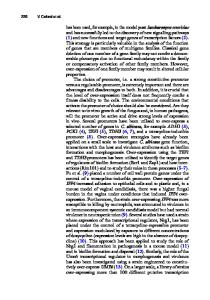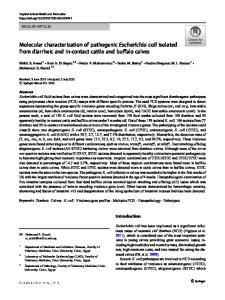Expression, purification, and characterization of phospholipase B1 from Candida albicans in Escherichia coli
- PDF / 1,134,933 Bytes
- 7 Pages / 595.276 x 790.866 pts Page_size
- 7 Downloads / 325 Views
ORIGINAL ARTICLE
Expression, purification, and characterization of phospholipase B1 from Candida albicans in Escherichia coli Zigang Zhao1 · Yaguang Zhou1 · Rui Wang3 · Fang Xie3 · Zhengyuan Zhai2 Received: 15 July 2020 / Accepted: 27 October 2020 © King Abdulaziz City for Science and Technology 2020
Abstract Candida albicans is an important fungal pathogen that causes a wide variety of human infections, ranging from mucocutaneous infections to life-threatening systemic infections. Phospholipase B1 (PLB1) has been reported to be directly responsible for C. albicans pathogenicity and is likely to be involved in the early steps of host invasion. Therefore, PLB1 could be a potential marker for diagnosis of C. albicans infection. In this study, PLB1 was expressed using an Escherichia coli expression system. Recombinant PLB1 is found in inclusion bodies and constitutes up to 38.4% of total insoluble protein. After refolding in a GSH/GSSG redox system, GST-tagged PLB1 was purified by GST-sepharose 4B affinity chromatography and then cleaved with thrombin to remove the GST-tag. The recombinant PLB1 was further purified by anion-exchange chromatography and reverse phase HPLC. The final yield of purified PLB1 was approximately 15.6 mg from 100 mL of bacterial cell culture, and its concentration was 784 μg/μL. The recombinant PLB1 could form a white precipitation zone on egg yolk agar plate, suggesting its phospholipase activity. Moreover, the maximum activity of PLB1 was 68 IU/mg at pH 6.0, 37 °C. Therefore, recombinant PLB1 has potential application in structural analytical studies, or diagnosis of C. albicans infection. Keywords Candida albicans · Phospholipase · GST-tagged PLB1 · Refolding · PLB1 activity
Introduction Candida albicans is a normally harmless organism that can be isolated from the gastrointestinal tract, and the oral and vaginal mucosa of many healthy individuals (Kim and Sudbery 2011; Chin et al. 2016). C. albicans is also an opportunistic pathogen in some immunocompromised people (Williams et al. 2013). It can infect the bloodstream (candidemia) or cause local mucosal infections, such as oropharyngeal candidiasis and vulvar vaginitis. C. albicans also causes invasive local infections including urethritis, *Zigang Zhao, Yaguang Zhou and, Rui Wang contributed equally to this work. * Zigang Zhao [email protected] 1
Department of Dermatology, Hainan Hospital of PLA General Hospital, Sanya, Hainan, China
2
College of Food Science and Nutritional Engineering, China Agricultural University, Beijing, China
3
Department of Dermatology, The First Medical Center PLA General Hospital, Beijing, China
endophthalmitis, and peritonitis pericarditis in immunodeficient or immunosuppressed patients (Kim and Sudbery 2011). In recent years, infection rates of C. albicans have increased due to interventional therapies, surgeries, cancer chemotherapy, and extensive use of various high-efficiency broad-spectrum antibiotics, immunosuppressants, and glucocorticoids (Pierce and Lopez-Ribot 2013). The increasi
Data Loading...











